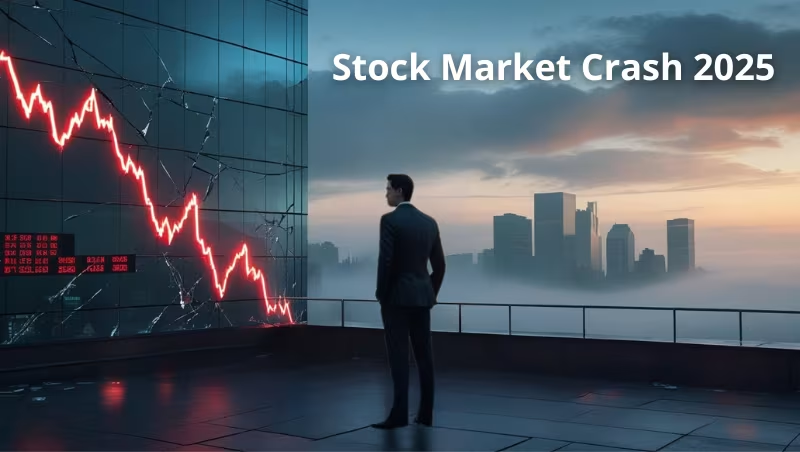Try it now!
Managing your investments has never been easier!

Markets rarely follow the script we expect. Back in May, JPMorgan Chase analysts lowered their U.S. recession probability to 40% from 60%, signaling a more optimistic economic outlook. Yet by July, volatility picked up — but instead of a broad crash, the S&P 500 is up roughly 7% year to date and has set fresh record highs; the stress shows more in market breadth and sector rotations than in headline index levels.
Volatility spiked. The VIX jumped above 60 in early April 2025 — the highest since the COVID shock. Average daily volume on the CME in Q2 was 30.2 million contracts, up 16% from a year earlier. Retirement savers flinched too: Alight’s 401(k) Index saw its busiest single trading day since March 2020 on April 7. Meanwhile, Bank of America’s June fund‑manager survey still found a net 36% underweight in U.S. equities, even as retail investors kept buying the dips.
The apparent paradox: recession odds eased, which should lift sentiment, yet investors remain uneasy—narrow leadership and policy uncertainty have left many feeling off‑balance even as indexes climb. This has led many to wonder if a market correction is coming, or if we're already in bear market territory.
History offers some perspective, though it doesn't provide easy answers. The previous bear market that started in December 2021 took the U.S. stock market about 18 months to recover. But will this downturn follow a similar pattern, or are we looking at something different? Market analysis remains divided, and their uncertainty shows in the latest unemployment rate projections. The Federal Reserve3 expects the jobless rate to rise to 4.5% by year-end.
Emerging markets add another layer of complexity to the stock market forecast. Part of their first‑half strength came from companies rushing U.S. imports ahead of expected tariffs—momentum that may now fade.
What's really driving this market panic? Which assets face the greatest risks, and where might opportunities emerge? What economic signals should we watch to understand what comes next? These questions matter because the current market dynamics suggest we're dealing with forces beyond typical market cycles.
A convergence of trade policy shocks, disappointing corporate earnings fundamentals, and sticky consumer inflation has upended market expectations, leading to a potential economic downturn.
Q2 earnings initially looked encouraging — 83% of S&P 500 companies beat analyst expectations. But the headline numbers masked underlying weakness. Overall earnings growth came in at just 4.8% for Q2, marking the slowest year-over-year expansion since late 2023.
The gains were concentrated in Tech and Communication Services, while Energy sank on cheaper oil. That narrow leadership meant that when big tech hesitated, the whole index slipped.
Meanwhile, analysts estimate the so-called "Magnificent Seven", the biggest AI-focused tech giants, will together spend roughly $320–$330 billion on 2025 capex, mostly for AI data centers and infrastructure. But that aggressive business investment, while signaling confidence in AI's long-term potential, has also fueled investor uncertainty about when these massive bets will deliver sustained profits.

Trump administration policies created the most immediate shock to financial markets. The Dow Jones Industrial Average plummeted 1,679 points, or nearly 4%, while the tech-heavy Nasdaq declined almost 6%. In just two days, more than $6 trillion in market value vanished from US stock markets, leading to widespread panic selling.
The policy details explain the severity. The 2025 plan set a 10% across‑the‑board tariff on most U.S. imports, while certain China‑sourced items (e.g., low‑value “de minimis” parcels) now face effective rates around 54%. China initially responded in early April with roughly 34% tariffs on selected U.S. goods, and Canada imposed 25% duties effective March 13, 2025. These back‑and‑forth measures injected immediate uncertainty into global supply chains and squeezed margins across import‑heavy industries, heightening fears of a broader trade war.
The economic impact hits American consumers directly. The average household faces approximately $3,800 in lost annual purchasing power due to these policies. This represents a significant headwind for consumer spending, which drives roughly 70% of U.S. economic activity.
The Federal Reserve held its policy rate steady at 4.25%-4.50%, defying Trump's calls to cut rates to 1%. With core PCE inflation running at 2.7%, above the Fed's 2% target, policymakers remained cautious about premature easing in this inflation environment.
This created tension between market expectations and Fed policy. Market participants still anticipate at least two 25-basis-point cuts by year-end, with some projections suggesting a larger 50-basis-point reduction in Q4. That gap between political/market pressure and the Fed’s data‑driven stance is adding another layer of policy uncertainty.
From its mid‑February 2025 high near 6,140, the S&P 500 fell about 10% to a March 13 low around 5,522—enough for a textbook correction (10%–20%), but not a bear market. The correction began in mid-March, meaning we're now about four months into it, slightly beyond the historical average correction length of 115 days. While the S&P 500 has clawed back some ground and remains up about 7% year-to-date, uncertainty persists.
Whether this remains a contained correction or deepens into a bear market will depend largely on evolving trade policy, corporate earnings, inflation pressures, and the Federal Reserve's next moves.
Investor behavior during this downturn reveals a striking divergence between institutional caution and retail optimism in the capital markets.
Retail investors have been buying aggressively during the May-July dips, encouraged by tariff pauses and what appeared to be resilient tech earnings. It's almost as if individual investors see buy points where professionals see risk. Meanwhile, institutional investors remain cautious. Bank of America's fund manager survey shows they've reduced their underweight position in U.S. equities from a peak of 36% in April to 23% in July, yet they remain net underweight.
What's particularly interesting is how retail investor behavior has evolved. A Federal Reserve Bank of Boston2 study finds retail investors now sell faster under stress than they did during the 2008 crisis, implying they’ve become more reactive, not calmer.
The AAII Investor Sentiment Survey captures this tension perfectly. We've seen six consecutive weeks of bearish sentiment in the 97th percentile or higher—the most extreme consecutive bearish reading since the 1970s. Historically, this kind of persistent pessimism often signals market rallies, though timing these contrarian moves is never straightforward.

These moves reflect more than just portfolio rebalancing. They signal deep concern about tariff fears, rising treasury yields, and the possibility that current economic policies might not deliver the stability investors expected.
Capital is rotating quickly as investors prioritize safety, income, and value.
Market breadth is still thin. Mega‑cap tech keeps driving most index gains, even as some names lag, Tesla4 is down ~18% YTD through July 18, 2025. At the same time, money has tiptoed into value/defensive groups: Industrials +13.3%, Utilities +10.4%, Financials +8.4% YTD, versus Technology +9.4% and Communication Services +9.2%. Several areas are still negative—Consumer Discretionary –2.1%, Health Care –1.4%. Translation: diversification matters; the rally is tech‑centric, but not tech‑only.
The bond market is telling a different story than the equity markets. As of July 2025, By mid‑July 2025, the 10‑year Treasury yield is still around the mid‑4% range, despite softer growth signals. Elevated yields likely reflect heavier Treasury supply and policy uncertainty, not booming growth. Investors have responded by shifting toward both core bond ETFs and flexible, actively managed bond funds.
Gold continues to outperform in 2025, surging nearly 32% year-to-date to around $3,438 per ounce. The rally is fueled by a mix of macroeconomic uncertainty, steady central bank demand, and renewed retail interest via ETFs. With inflation still elevated and geopolitical risks simmering, investors are increasingly viewing gold as a reliable hedge. J.P. Morgan forecasts the metal could approach $4,000 by mid-2026, reinforcing its role as a defensive cornerstone in diversified portfolios.
Emerging Markets face a particularly challenging environment as capital flees to safer havens. Currency moves complicate the picture: a weaker U.S. dollar since the tariff announcements eases some pressure on EM borrowers, but risk premiums remain elevated. Some MSCI risk metrics even show U.S. equities looking as volatile for euro/yen investors as traditional EM benchmarks—a rare alignment.
Commodity markets are under significant pressure across the board. Global commodity prices are expected to tumble 12% in 2025 and an additional 5% in 2026. Oil has been especially impacted, with Brent crude projected to average just $64/barrel in 2025 — a $17 decline from 2024 levels.
This downturn represents more than cyclical weakness. It reflects fundamental shifts in global trade patterns and demand expectations as economic growth projections continue to be revised downward.
Economic signals point to rising risks and diverging policy paths, leaving investors with few certainties.
Tech stocks remain the cornerstone of global equity markets—but that strength is increasingly under scrutiny. While the "Magnificent Seven" helped lift indices earlier in the year, concerns are mounting about stretched valuations. The tech sector now makes up about 33.9% of the S&P 500’s market cap, and trades at a ~29.7× forward P/E, versus 22.2× for the index overall. Ongoing investment in AI infrastructure keeps expectations high, but unless earnings growth catches up, this concentration may amplify downside risk. In a slowing global economy, tech's ability to sustain its leadership will be tested.
While JPMorgan has dialed U.S. recession odds back to around 40%, the economic backdrop remains challenging. GDP forecasts for 2025 have dropped to around 1%–1.5%, and the Atlanta Fed’s GDPNow model even briefly flirted with a negative print earlier this year. Meanwhile, cumulative tariffs, described by JPMorgan as the biggest tax hike in decades, continue to introduce drag on growth and heighten inflationary pressures.
Central banks are diverging, and the Fed is in a holding pattern. As of July 2025, the Federal Reserve has kept rates steady at 4.25%–4.50%, awaiting more clarity on inflation and growth. Most major banks expect just one rate cut of 25 basis points in December, bringing the year-end range to 4.00%–4.25% (per JPMorgan, Goldman Sachs, Barclays, and others). Some outliers, like UBS and Citigroup, forecast up to 100 bps in cuts starting as early as September, while Morgan Stanley and BofA expect no cuts at all in 2025.
By contrast, the European Central Bank has already cut rates eight times, now sitting at 2.00%, and the Swiss National Bank lowered rates to 0% in June. This divergence highlights the Fed's dilemma: while global central banks loosen policy to support growth, the U.S. faces tariff-driven inflation pressures that make aggressive easing riskier. Markets are pricing in around 75 bps of Fed cuts by year-end, but uncertainty remains high.
The next few months will be pivotal. Watch for Q3 earnings results to reveal whether corporate profits are rebounding beyond tech. Federal Reserve meetings in September and December could shift sentiment sharply, especially if rate cut expectations are adjusted. Any escalation or easing of tariffs will directly impact market stability, inflation, and consumer confidence. Meanwhile, gold, bond yields, and investor sentiment surveys will serve as real-time signals of market fear or resilience.
2025 has reminded investors that markets are shaped as much by policy shocks and behavioral shifts as by fundamentals. A 10% correction, sparked by tariffs and tightened liquidity, exposed just how fragile confidence can be, even amid falling recession odds.
From tech-heavy portfolios to emerging markets and commodity swings, few asset classes were spared. Defensive sectors, gold, and bonds offered shelter, while retail optimism clashed with institutional caution. As AI valuations stretch and rate policy stalls, the next phase for markets remains uncertain.
Whether this correction marks the start of deeper trouble or a reset before recovery will depend on what comes next from central banks, policymakers, and corporate earnings.
Now is the moment to reassess, not retreat. Strengthen your portfolio with broader diversification, clearer risk awareness, and data-driven insights. Tools like 8FIGURES can help you see where you're vulnerable and where opportunity still exists.
Want to know how exposed your portfolio is to today's risks? Let 8FIGURES AI analyze your diversification, sector weightings, and risk tolerance, so you can make informed investment decisions no matter what comes next.
REFERENCES
Managing your investments has never been easier!